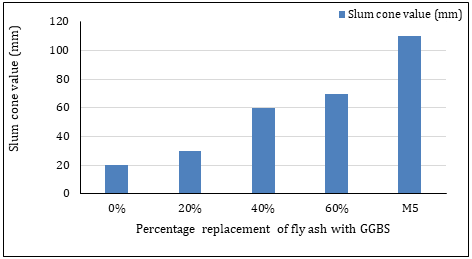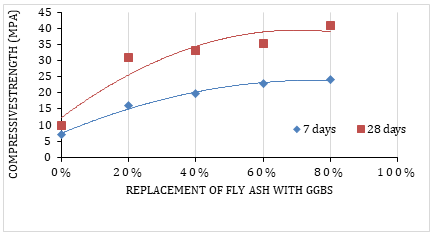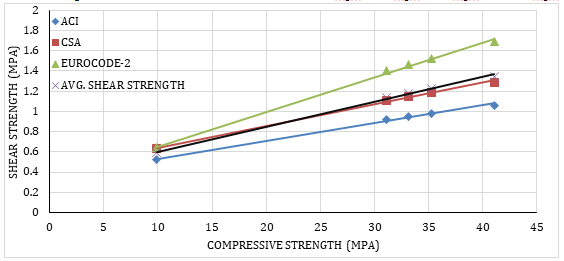Ijraset Journal For Research in Applied Science and Engineering Technology
- Home / Ijraset
- On This Page
- Abstract
- Introduction
- Conclusion
- References
- Copyright
Shear Strength of Fly Ash Based Geopolymer Concrete
Authors: Prof. Saurabh V. Talokar
DOI Link: https://doi.org/10.22214/ijraset.2024.64342
Certificate: View Certificate
Abstract
This paper present an experimental investigation of geopolymer concrete. Cement is one of the most important construction material. Cement is a backbone of civil engineering work. Development of whole world depends upon increasing infrastructure. For which cement is very necessary. Manufacturing of cement produce huge amount of carbon di-oxide and other greenhouse gases which is hazardous to the environment causes pollution. Hence it is very necessary to develop alternative binding material instead of cement for construction. Many researchers contribute their work on replacement of cement in concrete. Now a day’s various researchers contribute their research for using industrial waste instead of cement in concrete such as fly ash, Ground granulated blast furnace slag (GGBS) which form a geo-polymer concrete by adding alkaline material such as sodium silicate and sodium hydroxide. For design purpose shear strength is very important for any type of concrete because shear strength is very ductile in nature. So many researchers work on compressive strength, tensile strength, etc. but very few study is available on shear strength of fly ash geo-polymer concrete. Fly ash based geo-polymer concrete require elevated temperature for curing to improve strength properties and it impossible on actual site. In this project we can prepare fly ash based geopolymer concrete at ambient temperature curing by adding percentage of GGBS with fly ash to improve strength of concrete and obtained compressive strength and shear strength. From the result compressive strength and shear strength of concrete increases with increasing GGBS content with percentage of fly ash. Compressive strength of concrete at 28 days in ambient curing obtained is 9.88 Mpa, 31.10 Mpa, 33.15 Mpa, 35.27 Mpa and 41.07 Mpa for percentage replacement of GGBS with fly ash is 00%, 20%, 40%, 60% and 80% respectively and shear strength obtained is 0.59 Mpa, 1.14 Mpa, 1.18 Mpa, 1.23 Mpa and 1.34 Mpa for percentage replacement of GGBS with fly ash is 00%, 20%, 40%, 60% and 80% respectively. From above result it will be say that fly ash based geopolymer concrete may be used for construction purpose.
Introduction
I. INTRODUCTION
Fly ash-based geopolymer concrete is a radical change in construction material and concrete industry where no Portland cement is used and 100% of the cementitious material is industrial by-product, i.e., fly ash. The adoption of fly ash-based concrete is a good use of the massive fly ash land fill across the world resulting from the coal combustion power plants.
In structural and mechanical engineering, the shear strength of component is important for designing the dimensions and materials to be used by the manufacture or construction of the component. In a reinforced concrete beam, the main purpose of reinforcing bar stirrups is to increase the shear strength.
Cement is the most widely used manufactured material in the world. It is the essential ingredient of concrete production. In the past decades, numerous studies have been conducted to proportionally replace cement in concrete with waste material and industrial by-products such as fly ash (FA) and ground granulated blast furnace slag (GGBS) which reduces the greenhouse gas footprint associated with the cement manufacturing. Furthermore, using waste and industrial by-product materials will reduce the consumption of the non-renewable natural resources in construction creating more sustainable concrete. Utilizing fly ash in the concrete industry has not only been a good impact on the environment but also improves the durability and economy of concrete production. However, most of past studies limit the use of the supplementary cementitious materials to about 30% of the cement content [1].
The entire development of a country depends on the production value of power and consequently its consumption as energy. Our country, India needs huge power resources to meet the expectation of its occupant as well as its aim to be a developed nation by 2020. Fossil fuel plays an important part in meeting the demand for power generation .Coal is considered to be one of the world’s richest and widely distributed fossil fuel. Around the world, India dominates the third position in the largest production of coal and has the fourth largest coal reserves approx. (197 Billion Tons).
It has been estimated that 75% of India’s total installed power is thermal of which the share of coal is about 90%. Nearly about 600 Million tons of coal is produced worldwide every year, with Fly ash generation is about 500 MT at (60-78 %) of whole ash produced [2].
In engineering, shear strength is the strength of material or component against the type of yield or a structural failure when the material or components fails in shear. A shear load is the force that tends to produce a sliding failure on a material along the plan that is parallel to the direction of the force. When paper is cut with scissors, the paper fails in shear.
A review of previously published work indicates that very few studies have addressed the structural behaviour of fly ash-based geopolymer concrete. This project intends to investigate the shear behaviour of fly-ash based geopolymer concrete.
Geopolymer concrete is a new material to be develop for use of construction work which should be eco-friendly. The following are the properties of geopolymer concrete.
- Geopolymer concrete is set at ambient temperature
- It is nontoxic.
- It is durable having long life.
- It gives more strength
- It is bad thermal conductor and possess high resistance to ignoring solvent.
II. EXPERIMENTAL INVESTIGATION
Materials
1) Fly Ash
A unprocessed fly ash from sofia power plant, Nandgao peth, Amravati having specific gravity 1.84 used in this research.
2) GGBS (Ground Granulated Blast Slag):
GGBS is purchase from Magma iron pvt. Ltd. Nagpur. It is stored in tight bags. The GGBS having specific gravity 2.88.
3) Fine Aggregate:
Natural sand obtained from Wardha River was used as fine aggregate which was passing through 4.75mm IS sieve is use in this research having specific gravity 2.62, fineness modulus 3.02 and water absorption is 1%.
4) Course Aggregate:
Locally available coarse aggregate having maximum size of 20mm are used and minimum size of 12 mm are used as a coarse aggregate. The aggregate used having rounded shape and are smooth. Specific gravity of coarse aggregate calculated by pycnometer apparatus is obtained 2.71. Water absorption test carried out in lab on coarse aggregate and it is obtained 2%. Sieve analysis was carried out to find fineness modulus of coarse aggregate is 2.7045.
5) Sodium Hydroxide:
Locally available Sodium hydroxide is available in the form of flakes with purity of 97%-99% purity. According to required concentration sodium hydroxide is added in water to make solution. The specific gravity of Sodium hydroxide used in this research work is 1.99.
6) Sodium Silicate:
The sodium silicate was purchased from Rajas chemicals Khamgao at 30Rs per kg. A sodium silicate used in this project content Na2O=9%, SiO2=29%, Water=63% having specific gravity 1.5 is used in this research work.
III. METHODOLOGY
A. Mix Design of Geopolymer Concrete
Binder is the main difference between geopolymer concrete and ordinary Portland cement concrete. For the preparation of geopolymer concrete to form a paste of alkaline activator solution used to react with aluminosilicate material which is fly ash and GGBS. This alkaline activator solution act as a binder in geopolymer concrete. The fine and coarse aggregate occupy nearly 70% to 80% mass of geopolymer concrete.
The fine aggregate taken as 30% of total aggregate contained.2400 kg/m3 is the taken density of geopolymer concrete. Fly ash is replace by GGBS in the range of 20%, 40%, 60%, 80%. The ratio of sodium silicate to sodium hydroxide is 2.5 and the ratio of alkaline activator and fly ash ratio is 0.40 which is taken as constant throughout this study [5].
B. Preparation of Alkali Solution
Alkaline activation is a chemical process in which a powdery aluminosilicate such as fly ash is mixed with an alkaline activator to produce a paste capable of setting and hardening within a reasonably short period of time. The role of alkali activator solution is to dissolve the reactive portion of source materials Si and Al present in fly ash and provide a high alkaline liquid medium foe condensation. The alkaline activator play an important role in geo-polymer concrete. Alkaline activator play a fundamental role in the hydration of binders. Due to their characteristics, mortars and alkaline activated concretes can show higher mechanical resistance result than those obtained by a concrete made with OPC. The preparation of solution is done by dissolving sodium hydroxide in water. The concentration of sodium hydroxide changes with molarity. The quantity of sodium hydroxide solution with a concentration of 11M is calculated. The mass of NaOH solids in solution varied depending on the concentration of the solution express in terms of molar, M. The NaOH solution with concentration of 11M consisted of 11*40=440gm of NaOH solids per liter of the solution, where 40 is the molecular weight of NaOH. The mass of NaOH solids was measured as 306gm per kg of NaOH solution of 11M concentration. The sodium hydroxide added to the water and stirred about fifteen minutes to gel cool down. Then sodium silicate is added to the solution. This solution is used after 24 hours of its preparation. Both fly ash and GGBS are processed by appropriate technology and used for concrete works in the form of geopolymer concrete. The use of this concrete helps to reduce the stock of wastes and also reduces carbon emission by reducing Portland cement demand.
Table 1: Mix Design of Geopolymer concrete
|
Designation of mix |
Replacement of Fly ash with GGBS (%0 |
Fly ash (kg/m3) |
GGBS (kg/m3) |
Fine aggregate (kg/m3) |
Coarse aggregate (kg/m3) |
Alkaline solution |
|
|
NaOH (kg/m3) |
Na2SiO3 (kg/m3) |
||||||
|
M1 |
00 |
394.28 |
78.856 |
154.4 |
1293.6 |
45.06 |
112.65 |
|
M2 |
20 |
315.424 |
157.712 |
154.4 |
1293.6 |
45.06 |
112.65 |
|
M3 |
40 |
236.568 |
236.568 |
154.4 |
1293.6 |
45.06 |
112.65 |
|
M4 |
60 |
157.712 |
157.712 |
154.4 |
1293.6 |
45.06 |
112.65 |
|
M5 |
80 |
78.856 |
315.424 |
154.4 |
1293.6 |
45.06 |
112.65 |
C. Preparation of Test Specimen
1) Mixing
The alkaline activator prepared before 24 hours of casting. First mix all dry material upto 5 minutes properly in pan mixer. Alkaline activator solution is added slowly into that dry mix and then mixing is done properly upto next 5 minutes.
2) Casting
Properly mixed geopolymer concrete is poured immediately into the moulds. Concrete is placed in three layer with 25 blows of tamping rod to each layer. Clean and plane the surface of mould. A 100X100X100 mm size moulds are used for compressive strength and specially prepared ‘L’ size specimen of size [(150X150X150)-(60X90X150)] is used for shear strength.
3) Curing
After 24 hours moulds were demoulded and kept in room temperature for curing. The average temperature recorded during the period of curing was 37oC. The curing is done for 7 and 28 days.
IV. RESULT
A. Slum Cone Test:
After proper mixing of geo-polymer concrete it was taken for workability test. From figure: 2 following results of slum cone test are as follows:
1) When M1 mix having percentage of unprocessed fly ash is 100% taken for slum cone test slum obtained for this mix is highly harsh and we got a slum less concrete.
2) In M2 mix percentage of fly ash is 80% percent with replacement of 20% GGBS in it. Then slum obtained for this mix is somewhat harsh but workable than mix M1 and slum cone value is 30mm

Figure 1: Variation of slum cone value with replacement of fly ash by GGBS
3) For mix M3 percentage of fly ash taken as 60% and GGBS is 40% then the concrete is workable than mix M2 having slum 60mm but not workable for more time it get harsh in just 10-15 minutes.
4) In mix M4 percentage of fly ash taken as 40% and GGBS percentage is 60% then slum obtained is 70mm and concrete is workable up to 30 minutes.
5) When GGBS percentage is 80% and fly ash percentage is 20% in M5 mix then concrete obtained is workable for casting that above mix having value of slum is obtained with 110mm slum value which is workable le upto 40 minutes.
B. Compression Test
The compression test on cubes were conducted according to Indian standard specification (IS: 516-1959). Results shown in table 2.
Table 2: Compressive strength of geo-polymer concrete at 28 days at ambient temperature
|
Designation of mix |
Compressive strength at 7 (Mpa) |
compressive strength at 28 days (Mpa) |
|
M1 |
7.07 |
9.88 |
|
M2 |
15.98 |
31.10 |
|
M3 |
19.78 |
33.15 |
|
M4 |
22.94 |
35.27 |
|
M5 |
24.11 |
41.07 |

Figure: 2 Graphical representation of Compressive strength of Geo-polymer concrete in ambient temperature with replacement of fly ash by GGBS.
Figure 2 shows that as percentage of GGBS increase in concrete then compressive strength at 7 days increases polynomially over percentage replacement of fly ash by GGBS. Curve show that there is an up down or fluctuation in increment of compressive strength. Compressive strength of concrete at 28 days also shows polynomial curve means there is increment in compressive strength as GGBS increases in concrete but there are more fluctuations are between them.
C. Shear strength
From literature survey it has been evaluate that shear strength from different standard codes and publisher gives a formula about shear strength of plain concrete in terms of compressive strength.
American concrete institute (ACI) committee 318 (2002) publish a building code requirements for structural concrete (ACI 318-02) [12] mention shear strength formula for general plain concrete in chapter 22 are as shown in equation 1.
VC = 0.166√ fck Equ. (1)
fck Equ. (1)
Where, VC = Shear strength of concrete in Mpa,
fck = Characteristic compressive strength in Mpa.
In designer’s handbook of Eurocode-2 part 1.1, Design of concrete structures, Telford, London (1995) [11] provides a formula for shear strength of plain concrete mention below in equation 2.
TRD = (0.25fctk, 0.05) / YC Equ. (2)
Where, TRD= Shear strength of concrete in Mpa,
0.25fctk, 0.05 = Formula for 5% fractile tensile strength
= 0.7 fctm
fctm = Mean tensile strength
= 0.3 (fck) 0.67
YC = Factor of safety = 1.5
In Canadian standard association (CSA) technical committee on reinforced concrete design (1994), Design of concrete structure A23.3-94 gives a formula for shear strength of plain concrete [13] mention in equation 3.
VC = 0.2√ fck Equ. (3)
fck Equ. (3)
Where, VC = Shear strength of concrete in Mpa,
fck = Characteristic compressive strength in Mpa
Shear strength values of fly ash based geo-polymer concrete according to above formulae with reference to compressive strength of fly ash based geo-polymer concrete are as shown in table 3.
Table 3: Shear strength of concrete
|
Designation of mix |
compressive strength at 28 days (Mpa) |
Shear strength of concrete on the basis of compressive strength (Mpa) |
Average shear strength (Mpa) |
|||
|
ACI |
CSA |
EUROCODE-2 |
||||
|
M1 |
9.88 |
0.52 |
0.63 |
0.64 |
0.59 |
|
|
M2 |
31.10 |
0.92 |
1.11 |
1.40 |
1.14 |
|
|
M3 |
33.15 |
0.95 |
1.15 |
1.46 |
1.18 |
|
|
M4 |
35.27 |
0.98 |
1.19 |
1.52 |
1.23 |
|
|
M5 |
41.07 |
1.06 |
1.28 |
1.69 |
1.34 |
|
From table 4.3 we got a values of shear strength of geo-polymer concrete on the basis of different standard codes i.e. ACI, CSA, EUROCODE-2. From that values we take an average shear strength of all three values as a shear strength of geopolymer concrete. From above table we can say that as percentage of GGBS increases in geo-polymer concrete shear strength of concrete also increases. When percentage of fly ash is 100% in geo-polymer concrete we got 0.59 Mpa shear strength then as we increases GGBS percentage then shear strength increases for mix M2, M3, M4 & M5 is 1.14 Mpa, 1,18 Mpa, 1,23 Mpa and 1.34 Mpa respectively.

Figure 2: Graph showing variation between shear strength and compression strength
Above graph of compressive strength and shear strength shows there is a linear variation in shear strength with respect to compressive strength. From above graph we can say that as compression strength of concrete increases by day wise then there is also increment in shear strength of concrete. From above result and literature survey we can say that as percentage of GGBS increases in fly ash based geo-polymer concrete then its compressive strength increases [7].
Conclusion
On the basis of present study following conclusions on fresh state and harden state of geo-polymer concrete can be drawn: 1) As percentage of GGBS with percentage replacement of fly ash increases in geo-polymer concrete workability increases. 2) GGBS increases in concrete by the percentage of fly ash is 00%, 20%, 40%, 60% and 80%. 3) Slum in geo-polymer concrete are 20mm, 30mm, 60mm, 70mm and 110mm for the replacement of fly ash with GGBS for 00%, 20%, 40%, 60% and 80% respectively. 4) After studying compressive strength result it is found that compressive strength increases with increasing GGBS content in concrete. 5) Compressive strength of concrete at 7 days are found to be 7.07 Mpa, 15.98 Mpa, 19.78 Mpa, 22.94 Mpa and 24.91 Mpa for the mix containing replacement GGBS with fly ash is 0%, 20%, 40%, 60% and 80% respectively. 6) Compressive strength of concrete at 28 days are found 9.88 Mpa, 31.10 Mpa, 33.15 Mpa, 35.27 Mpa and 41.07Mpa for the mix containing replacement GGBS with fly ash is 0%, 20%, 40%, 60% and 80% respectively. 7) Shear strength of the geo-polymer concrete increases with increasing GGBS percentage with fly ash is by 00%, 20%, 40%, 60% and 80%. 8) When replacement of fly ash by GGBS is 00%, 20%, 40%, 60% and 80% then obtained shear strength is 0.59 Mpa, 1.14 Mpa, 1.18 Mpa, 1.23 Mpa and 1.34 Mpa respectively. 9) From the ACI, CSA, EUROCODE-2 maximum value of shear strength obtained is 1.34 Mpa for 80% GGBS and 20% fly ash mix. 10) It is found that the shear strength of geo-polymer concrete is obtained maximum by EUROCODE-2 than CSA and ACI. 11) As we can say that Increase in Ground granulated blast furnace slag in geo-polymer concrete in percentage of fly ash increases compressive strength of geo-polymer concrete as well as shear strength of geo-polymer concrete. 12) Cement can be replace by geo-polymer binder such as fly ash and GGBS in concrete. It helps in reducing carbon di-oxide emission.
References
[1] B.Laxman Raju, L.Sudheer Reddy, Sumanth Kumar B “Interface Shear of Fly ash and GGBS Based Geopolymer Concrete” IJTIMES, e-ISSN: 2455-2585 Volume 5, Issue 04, April-2019 [2] Satyajit kumar “Investigation of fly ash polymer composite” national institute of technology Rourkela. [3] Benny JOSEPH, George Mathew “interface shear strength of fly ash based geopolymer concrete” International Journal of Engineering, 2013. [4] Subhash V. Ptankar “ Mix design of fly ash based geo-polymer concrete” Conference paper2014 https://www.researchgate.net/publication/275340304 [5] Rohit Zende, Mamtha A. “Study On Fly Ash and GGBS Based Geopolymer Concrete under Ambient Curing” JETIR (ISSN-2349-5162), July 2015, Volume 2, Issue 7 [6] Dhanabal G., Dr. V. Sreevidya “Shear Strength Characteristics of Self Compacting Geopolymer Concrete Cast at Different Ages” International Journal of Latest Engineering and Management Research (IJLEMR) ISSN: 2455-4847, April 2019 [7] J. Guru Jawahar, D. Lavanya, C. Sashidhar “Performance of fly ash and GGBS based geo-polymer concrete in acid environment” International journal of research and scientific innovation (IJRSI), Volume-III, Issue 8 August 2016. [8] IS 456-2000 Plain and reinforces concrete-code of practice (forth revision), Bureau of Indian Standards, New Delhi. [9] IS 10262-1970 recommended guidelines for concrete mix design on for coarse and fine Aggregates from natural sources for concrete. Bureau of Indian Standards, New Delhi [10] IS 383-1970 Specification for coarse and fine aggregates from natural sources for concrete. Bureau of Indian Standards, New Delhi. [11] Beeby, A. W. and Narayanan, R. S. Designers handbook to Eurocode 2 part 1.1, Design of concrete structures, Telford, London (1995). [12] ACI committee 318. (2002), Building code requirements for structural concrete and commentary. American concrete institute, USA (2002). [13] CSA technical committee on reinforced concrete design (1994). Design of concrete structures A23.3-094, Canadian standard association, Canada (1994).
Copyright
Copyright © 2024 Prof. Saurabh V. Talokar. This is an open access article distributed under the Creative Commons Attribution License, which permits unrestricted use, distribution, and reproduction in any medium, provided the original work is properly cited.

Download Paper
Paper Id : IJRASET64342
Publish Date : 2024-09-25
ISSN : 2321-9653
Publisher Name : IJRASET
DOI Link : Click Here
 Submit Paper Online
Submit Paper Online

